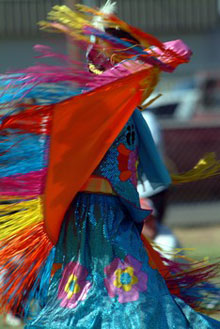Urban American Indian community centers in the United States can look to their neighbors to the north for an example of how to create a strong national voice, says Dana Klar, J.D., founding and interim director of the Kathryn M. Buder Center for American Indian Studies at Washington University in St. Louis.

“Urban American Indian community centers were created in the late 1950s and 60s as a part of the federal relocation policy, with the aim of re-settling native persons in urban areas, where we would be closer to schools, jobs and more easily assimilated,” says Klar, a member of the United Houma Nation.
Today, nearly 60 percent of American Indians reside off-reservation, and because of that, the majority of American Indians do not have ready access to the cultural and financial services provided by tribal and federal agencies on the reservations.
“We have more recently realized that a national organization can aid the individual centers in advocacy and policy development efforts that affect all urban American Indians,” Klar says.
“It has only been in the last four or five years that steps have been taken to organize our individual centers on a national scale. Canada’s urban Indian coalition, the National Association of Friendship Centres (NAFC), which has been in existence for 35 years, can serve as an inspiration for the growing urban Indian movement in the United States.”
Canada’s NAFC successfully represents the needs of urban Indians across the country to the Canadian government and to the public. The NAFC provides advocacy services, funding support, training and technical assistance, an annual conference including youth and leadership development, as well as oversight, and a unified code of ethics for the 117 Friendship Centres across Canada.
Creating formal alliances
According to the U.S. National Urban Indian Family Coalition (NUIFC), which was created in 2003, urban Indians, like other minority groups, are disproportionately prone to suffer from socio-economic distress.
Nonprofit urban Indian community centers, which are funded through a variety of sources, seek to meet many of the underserved needs of urban Indians, including health, employment training, housing, culture and welfare. Because they are not governmental entities, however, urban Indian centers struggle to provide services that are provided on reservations.
“I think our Canadian cousins have a lot to teach us by way of organizing in such a way as to have a legitimate and powerful voice within the policy and political landscape in Canada,” says Janeen Comenote, NUIFC coordinator.
St. Louis exemplifies the need for formalized urban Indian alliances.

“St. Louis, as one of the original relocation cities, has a sizeable, largely unseen, but certainly impassioned, urban native community, actively engaging in activities through at least five organized groups,” says Klar. “One goal of mine, through my work with the Buder Center, and a long-time member of the St. Louis urban native community, is the creation of an alliance or coalition of these groups, so that on occasion, a larger body may meet in service to all.”
Klar hopes that these urban Indian alliances can provide many tangible, and even more intangible benefits such as:
• A unified voice to affect more global policy change;
• an organized group to pursue large-scale grants that can serve all urban groups, and allow for shared resources;
• Creation of more public awareness in urban areas; and
• Improved access to financial and cultural services.
Representatives from Canada’s NAFC came to Washington University in early April to discuss their community organizing strategies.
“We’re incredibly fortunate to have representatives from this vibrant group come to the university to engage with the students and the St. Louis community,” says Miriam Jorgensen, Ph.D., visiting scholar at Washington University.
“In both the United States and Canada, non-reservation and urban native populations are growing rapidly. It’s the new reality for community development with Indigenous peoples — a reality that the Friendship Centre movement in Canada has addressed with great success.”